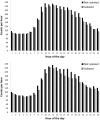Associations between social isolation, loneliness, and objective physical activity in older men and women
- PMID: 30651092
- PMCID: PMC6335852
- DOI: 10.1186/s12889-019-6424-y
Associations between social isolation, loneliness, and objective physical activity in older men and women
Abstract
Background: The impact of social isolation and loneliness on health risk may be mediated by a combination of direct biological processes and lifestyle factors. This study tested the hypothesis that social isolation and loneliness are associated with less objective physical activity and more sedentary behavior in older adults.
Methods: Wrist-mounted accelerometers were worn over 7 days by 267 community-based men (n = 136) and women (n = 131) aged 50-81 years (mean 66.01), taking part in the English Longitudinal Study of Ageing (ELSA; wave 6, 2012-13). Associations between social isolation or loneliness and objective activity were analyzed using linear regressions, with total activity counts and time spent in sedentary behavior and light and moderate/vigorous activity as the outcome variables. Social isolation and loneliness were assessed with standard questionnaires, and poor health, mobility limitations and depressive symptoms were included as covariates.
Results: Total 24 h activity counts were lower in isolated compared with non-isolated respondents independently of gender, age, socioeconomic status, marital status, smoking, alcohol consumption, self-rated health, limiting longstanding illness, mobility limitations, depressive symptoms, and loneliness (β = - 0.130, p = 0.028). Time spent in sedentary behavior over the day and evening was greater in isolated participants (β = 0.143, p = 0.013), while light (β = - 0.143, p = 0.015) and moderate/vigorous (β = - 0.112, p = 0.051) physical activity were less frequent. Physical activity was greater on weekdays than weekend days, but associations with social isolation were similar. Loneliness was not associated with physical activity or sedentary behavior in multivariable analysis.
Conclusions: These findings suggest that greater social isolation in older men and women is related to reduced everyday objective physical activity and greater sedentary time. Differences in physical activity may contribute to the increased risk of ill-health and poor wellbeing associated with isolation.
Keywords: Ageing; Loneliness; Objective physical activity; Older adults; Social isolation.
Conflict of interest statement
Ethics approval and consent to participate
The English Longitudinal Study of Ageing was approved by the National Research Ethics Service and participants gave informed consent. Data are available to registered users of the UK Data Service.
Consent for publication
Not applicable.
Competing interests
The authors declare that they have no competing interests.
Publisher’s Note
Springer Nature remains neutral with regard to jurisdictional claims in published maps and institutional affiliations.
Figures


References
-
- Berkman LF, Krishna A. Social network epidemiology. In: Berkman LF, Kawachi I, Glymour MM, editors. Social Epidemiology. 2. New York, NY: Oxford University Press; 2015. pp. 234–289.
MeSH terms
Grants and funding
LinkOut - more resources
Full Text Sources
Medical

